In 2004 the United States Postal Service released a 37 cent postage stamp to honor Buckminster Fuller’s life and work. As part of their release of the postal stamp on July 12, 2004 — the 50th anniversary of Bucky’s invention of the geodesic dome — biographical materials were prepared with the editorial assistance of the Estate.
“The stamp artwork is a painting of Fuller by Boris Artzybasheff (1899-1965). The painting, which originally appeared on the cover of Time magazine on January 10, 1964, depicts Fuller's head in the pattern of a geodesic dome.” - USPS
USPS STAMP BIOGRAPHY
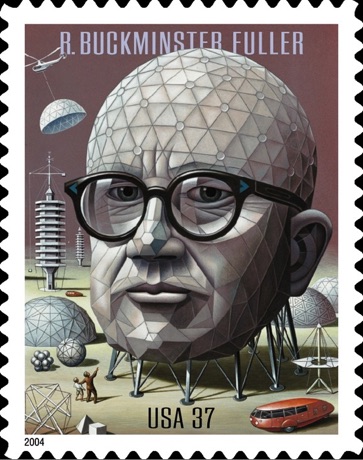
STAMP PROGRAM APPROVAL FORM
DATE: February 11, 2004
SUBMISSION DESCRIPTION: Stamp art and background information.
PHILATELIC PRODUCT: R. Buckminster Fuller: United States Postal Service postage stamp.
NAME OF HONOREE: R. Buckminster Fuller
Date of birth: July 12, 1895
Place of birth: Milton, Massachusetts
Date of death: July 1, 1983
SUBJECT BRIEF: BACKGROUND TEXT PREPARED BY U.S. POSTAL SERVICE
This 2004 stamp honors inventor, architect, engineer, designer, geometrician, cartographer, and philosopher R. Buckminster Fuller (1895-1983) on the 50th anniversary of his patent for the geodesic dome, his most famous invention. Hailed as “one of the greatest minds of our times,” Fuller was renowned for his comprehensive perspective on the world’s problems. For more than five decades, he developed pioneering solutions that reflected his commitment to the potential of innovative design to create technology that does “more with less” and thereby improves human lives.
Born in Milton, Massachusetts, on July 12, 1895, Richard Buckminster Fuller belonged to a family noted for producing strong individualists inclined toward activism and public service. “Bucky,” as he came to be called, developed an early understanding of nature during family excursions to Bear Island, Maine, where he also became familiar with the principles of boat maintenance and construction.
Fuller entered Harvard University in 1913, but he was expelled after excessively socializing and missing his midterm exams. Following his expulsion, he worked at a mill in Canada, where he took a strong interest in machinery and learned to modify and improve the manufacturing equipment. Fuller returned to Harvard in the autumn of 1915 but was again dismissed.
From 1917 until 1919, Fuller served in the U.S. Navy, where he demonstrated his aptitude for engineering by inventing a winch for rescue boats that could remove downed airplanes from the water in time to save the lives of pilots. As a result of the invention, Fuller was nominated to receive officer training at the U.S. Naval Academy, where he further developed his ability to study problems comprehensively.
In 1926, when Fuller’s father-in-law, James Monroe Hewlett, developed a new method of producing reinforced concrete buildings, he and Fuller patented the invention, earning Fuller the first of his 25 patents.
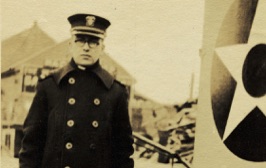
In 1927, after the construction company failed, Fuller was unemployed and contemplated suicide, but he had a remarkable realization. Deciding that he had no right to end his own life, he concluded that he had a responsibility to use his experiences and intellect in the service of others. As a consequence, he spent nearly two years as a recluse, deep in contemplation about the universe and how he could best contribute to humanity.
One of Fuller’s lifelong interests was using technology to revolutionize construction and improve human housing. In 1927, after inventing an easily built, air-delivered, modular apartment building, he designed the Dymaxion™ House, an inexpensive, mass-produced home that could be airlifted to its location. Originally called the 4D House, it was later renamed by a department store that displayed a model of the house. The word “dymaxion” was coined by store advertisers and trademarked in Fuller’s name. Based on the words “dynamic,” “maximum,” and “ion,” it became a part of the name of many of Fuller’s subsequent inventions. The word became synonymous with his design philosophy of “doing more with less,” a phrase he later coined to reflect his growing recognition of the accelerating global trend toward the development of more efficient technology.
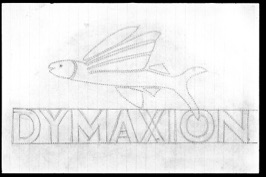
After 1947, one invention dominated Fuller’s life and career: the geodesic dome. Lightweight, cost-effective, and easy to assemble, geodesic domes enclose more space without intrusive supporting columns than any other structure; they efficiently distribute stress; and they can withstand extremely harsh conditions. Based on Fuller’s “synergetic geometry,” his lifelong exploration of nature’s principles of design, the geodesic dome was the result of his revolutionary discoveries about balancing compression and tension forces in building.
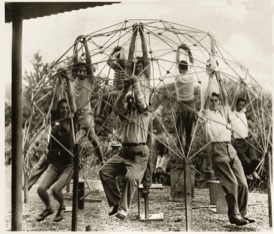
Fuller applied for a patent for the geodesic dome in 1951 and received it in 1954. In 1953 he designed his first commercial dome for the Ford Motor Company headquarters in Dearborn, Michigan. The U.S. military became one of his biggest clients, using lightweight domes to cover radar stations at installations around the Arctic Circle. According to the Buckminster Fuller Institute, today there are more than 300,000 geodesic domes around the world, ranging from shelters in California and Africa to radar stations in remote locations, as well as geodesic structures on countless children’s playgrounds.
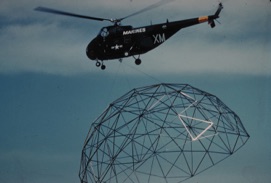
Fuller was a pioneering global thinker. In 1927, at the beginning of his career, he made a now-prophetic sketch of the total earth which depicted his concept for transporting cargo by air “over the pole” to Europe. He entitled the sketch “a one-town world.” In 1946, Fuller received a patent for another breakthrough invention: the Dymaxion Map, which depicted the entire planet on a single flat map without visible distortion of the relative shapes and sizes of the continents. The map, which can be reconfigured to put different regions at the center, was intended to help humanity better address the world’s problems by prompting people to think comprehensively about the planet. In the early 1950’s he coined the now familiar phrase “spaceship earth” to describe the integral nature of Earth’s “living system.” Beginning in the late 1960s, Fuller was especially involved in creating World Game®, a large-scale simulation and series of workshops he designed that used a large-scale Dymaxion Map to help humanity better understand, benefit from, and more efficiently utilize the world’s resources.

Throughout his life, Fuller found numerous outlets for his innovative ideas. During the early 1930s he published Shelter magazine, and from 1938 until 1940 he was science and technology consultant for Fortune magazine. During the 1940s he began to teach and lecture at universities, including Harvard and MIT, and in the late 1950s he became a professor at Southern Illinois University (SIU), where he and his wife lived in a geodesic dome when he was in residence. In 1972 he was named World Fellow in Residence to a consortium of universities in Philadelphia, including the University of Pennsylvania. He retained his connection with both SIU and the University of Pennsylvania until his death. He was the author of nearly 30 books, and he spent much of his life traveling the world lecturing and discussing his ideas with thousands of audiences. Some of Fuller’s many honors highlight his eclectic reputation: For example, because he sometimes expressed complex ideas in verse to make them more understandable, in 1961 he received a one-year appointment to the prestigious Charles Eliot Norton Professorship of Poetry at Harvard.
After being spurned early in his career by the architecture and construction establishments, Fuller was later recognized with many major architectural, scientific, industrial, and design awards, both in the United States and abroad, and he received 47 honorary doctorate degrees. In 1983, shortly before his death, he received the Presidential Medal of Freedom, the nation’s highest civilian honor, with a citation acknowledging that his “contributions as a geometrician, educator, and architect-designer are benchmarks of accomplishment in their fields.”

After Fuller’s death, when chemists discovered that the atoms of a recently discovered carbon molecule were arrayed in a structure similar to a geodesic dome, they named the molecule “buckminsterfullerene.”
R. Buckminster Fuller died in Los Angeles on July 1, 1983.
Buckminster Fuller™, Dymaxion™ and World Game® are trademarks of the Estate of Buckminster Fuller. Spaceship Earth® is a registered trademark of the Buckminster Fuller Institute. This license represented by The Roger Richman Agency, Inc.

DESIGN BRIEF: TO BE USED BY U.S. POSTAL SERVICE TO DESCRIBE STAMP
The stamp artwork is a painting of Fuller by Boris Artzybasheff (1899-1965). The painting, which originally appeared on the cover of Time magazine on January 10, 1964, depicts Fuller's head in the pattern of a geodesic dome. Fuller is surrounded by geodesic domes and a number of his other inventions, including the Dymaxion™ Car, a geodesic dome being airlifted by helicopter, the 4D Apartment House, and several objects and models that reflect the geometric and structural principles he discovered.
I have reviewed the above-referenced enclosed submission, and my comments are as follows (please check the appropriate response):
_____ APPROVED
_____ APPROVED WITH THE FOLLOWING CHANGE(S):
__________________________________________________________________________________
_____ DISAPPROVED FOR THE FOLLOWING REASON(S):
__________________________________________________________________________________
Please sign below and return the complete submission to the following:
Layne D. Owens, Stamp Development, United States Postal Service, 475 L’Enfant Plaza, S.W., Room 5670, Washington, D.C. 20260-2435
Grantor’s signature Date
Allegra Fuller Snyder
Grantor’s name (please print or type)

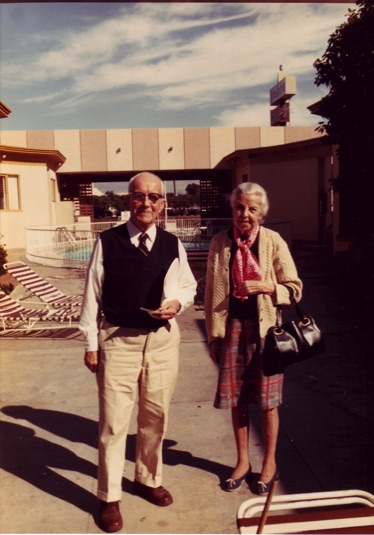
Bucky and wife Anne
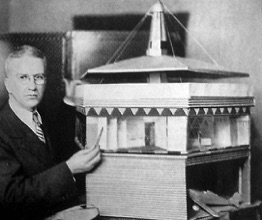
Courtesy Stanford University
Event at Stanford On Bucky: Buzz Aldrin, Allegra Fuller Snyder (Bucky’s daughter) et al
On a further historical note, the first day of issue ceremony was held at Stanford University on July 12, 2004 where the stamp was officially unveiled at the Cubberley Auditorium. In attendance were Bucky’s daughter Allegra, astronaut Buzz Aldrin, and officials from USPS and Stanford. Amongst the pomp and circumstance, Allegra stated pithily, “What this stamp ultimately challenges us to do is not to be afraid to do our own thinking." For more information, see this formal news release:
Bucminster Fuller stamp launched at campus ceremony.
TEXT OF CAPTION TO APPEAR ON BACK OF COMMEMORATIVE STAMP
Renowned as the mind behind the geodesic dome, R. Buckminster Fuller (1895-1983) was an inventor, architect, engineer, designer, geometrician, cartographer, and philosopher. His pioneering solutions to the world’s problems reflected his commitment to using innovative design to improve human lives.
These inventions included the Dymaxion Car, a streamlined, three-wheeled automobile that could make extraordinarily sharp turns; a compact, prefabricated, easily installed Dymaxion Bathroom; and Dymaxion Deployment Units (DDUs), mass-produced houses based on circular grain bins. While DDUs never became popular for civilian housing, they were used during World War II to shelter radar crews in remote locations with severe climates, and they led to additional round housing designs by Fuller.
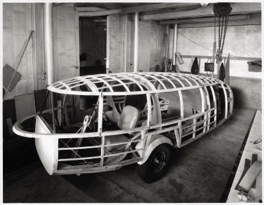
Contact us at b.fuller.estate@gmail.com | (712) 227-1576
THE ESTATE OF R. BUCKMINSTER FULLER


